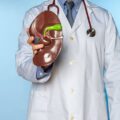COMMENT:
As a result, lifestyle interventions, including physical exercise and dietary modifications, remain the primary approach to managing both NAFLD and non-alcoholic steatohepatitis (NASH), its progressive subtype.
This review aimed to describe the current clinical understanding of appropriate physical and dietary interventions for patients with NAFLD.
KEY LEARNINGS:
The loss of 5-7% of body weight has been shown to reverse steatosis in NAFLD patients. Similarly, a loss of 10% may aid in reversing fibrosis, whereas a loss of ≥7% of body weight can lead to NASH resolution. In adult patients with NAFLD but without overweight or obesity, a weight loss of 3-5% is recommended. This may be achieved via a low-carbohydrate Mediterranean diet, reductions in fructose intake, and medically-supervised supplementation with high doses of vitamin E. Such healthy diet principles, combined with increases in protein intake, are especially effective for patients with cirrhotic NASH. Similarly, high or medium intensity aerobic exercise and resistance training is associated with significant health benefits for NAFLD and NASH patients. This may be enabled via web-based programmes as their net health benefits are comparable to that of in-person initiatives. Ultimately, assisting in the weight loss of NAFLD patients should be a clinical priority. Moreover, recognition of NAFLD patients with sedentary lifestyles fatigued by comorbid sarcopenia must be achieved to enable their effective clinical management.


Hepatic inflammatory responses in liver fibrosis